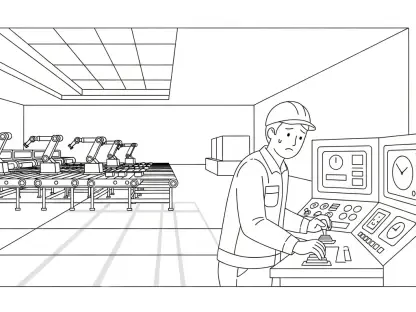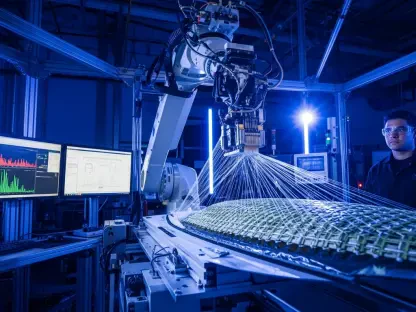In the relentless pace of today’s global economy, supply chains are grappling with an unprecedented array of disruptions, from trade tariffs wielded as geopolitical weapons to climate-driven logistics chaos, persistent labor shortages, and outdated technological frameworks. Businesses often find themselves trapped in a cycle of reactive, disjointed operations, struggling to meet customer expectations while navigating unpredictable market shifts. The path to overcoming these hurdles lies in a transformative approach—building agile ecosystems through automation. This strategy offers more than mere survival; it positions companies to gain a significant competitive advantage. By delving into how automation can reshape supply chains, this discussion uncovers the tools and strategies needed to turn volatility into opportunity. With real-time insights and integrated systems, firms can create resilient operations that anticipate challenges and adapt swiftly, ensuring they remain ahead in an era defined by uncertainty.
Navigating the Storm of Supply Chain Disruptions
Today’s supply chains operate in a landscape marked by complex, interconnected challenges that render traditional manual approaches ineffective. Factors such as tariffs used for political leverage, extreme weather events disrupting key logistics hubs, ongoing shortages of skilled labor, and aging digital infrastructure create a highly unstable environment. These issues are not isolated but form a web of systemic risks that demand a forward-thinking response. Companies can no longer afford to address problems only after they arise, as the cost of delayed action is steep—missed deadlines and broken commitments can severely damage both reputation and revenue. Automation emerges as a critical solution, enabling the integration of fragmented processes into a unified, responsive system. By connecting every link in the supply chain, businesses gain the ability to withstand unexpected shocks, ensuring operations continue smoothly even under pressure. This shift from reaction to anticipation marks the foundation of an agile ecosystem capable of enduring persistent volatility.
The impact of these disruptions extends beyond immediate operational hiccups, affecting long-term trust and market positioning. When supply chains falter due to a lack of adaptability, the ripple effects are felt in eroded customer confidence and strained partnerships. A delayed shipment or unfulfilled order can quickly translate into lost business and diminished brand loyalty. Moreover, investors are increasingly scrutinizing supply chain performance as an indicator of overall corporate health, making resilience a priority for maintaining market confidence. Automation addresses these concerns by providing a framework for proactive management, where potential issues are identified and mitigated before they escalate. This capability not only safeguards against immediate losses but also builds a reputation for reliability in a market where consistency is a rare commodity. As disruptions become the norm rather than the exception, embracing automated solutions becomes essential for any company aiming to secure its place in a competitive landscape.
Harnessing Automation for Real-Time Responsiveness
Central to creating an agile supply chain is the integration of automation with real-time visibility, a combination that redefines operational efficiency. Automated orchestration streamlines essential functions such as ordering, procurement, fulfillment, and invoicing, embedding transparency and accountability into every stage of the process. This goes beyond simply speeding up tasks; it equips businesses with the ability to make informed decisions at a moment’s notice, sidestepping the costly delays inherent in manual systems. When processes are synchronized through automation, the risk of errors diminishes, and the flow of goods and information becomes seamless. Such efficiency is vital in a market where timing can determine success or failure, allowing companies to meet customer demands with precision. The shift to automated systems represents a fundamental change in how supply chains operate, moving from fragmented efforts to a cohesive, dynamic network ready to tackle challenges head-on.
Real-time visibility serves as the linchpin of this transformation, offering a clear window into every aspect of the supply chain at any given moment. With comprehensive, up-to-the-minute data, businesses can detect potential disruptions—be it a delayed shipment or a sudden inventory shortfall—before they spiral into larger problems. This foresight enables dynamic adjustments, such as rerouting shipments or reallocating resources, to maintain operational continuity. The significance of this capability cannot be overstated; it turns a traditionally reactive operation into a proactive ecosystem that anticipates market shifts and customer needs. Evidence from market performance metrics indicates that companies equipped with these tools consistently outpace their peers, particularly during periods of upheaval. Automation and visibility together form a powerful duo, establishing a new benchmark for supply chain management where adaptability is not just an advantage but a necessity for staying competitive in an unpredictable world.
Leveraging Technology and Strategy for Resilience
The role of cutting-edge technology, especially artificial intelligence (AI) and data analytics, is pivotal in constructing agile supply chains that can weather any storm. These innovations provide predictive insights, allowing businesses to foresee demand fluctuations or supply constraints and act before issues materialize. By analyzing vast datasets, AI can identify patterns and trends that human oversight might miss, offering a strategic edge in planning. When paired with tactical approaches like supplier diversification—reducing reliance on a single source—and dynamic pricing to manage cost spikes, automation elevates supply chains from mere operational necessities to drivers of business growth. This transformation reframes the supply chain as a strategic asset, capable of delivering value beyond cost management. Technology thus becomes the backbone of agility, enabling firms to navigate volatility with confidence while capitalizing on emerging opportunities in a shifting market.
However, technology alone cannot achieve lasting resilience without the right human and organizational elements in place. Workforce training to address skill gaps, particularly in using advanced software and tools, is critical to maximizing the benefits of automation. Equally important is cross-functional alignment, where departments collaborate seamlessly to ensure that technological implementations align with broader business goals. A cultural commitment to adaptability—where every level of the organization prioritizes flexibility and innovation—further amplifies the impact of these investments. Without this holistic approach, even the most sophisticated systems risk underperforming due to resistance or misuse. Companies that balance technological advancements with strategic human capital development create supply chains that not only endure turbulent conditions but also position themselves as leaders in efficiency and customer satisfaction. This synergy of tools and talent is what ultimately turns disruption into a proving ground for competitive strength.
Bridging the Gap Between Automation and Obsolescence
A stark divide exists between companies that have adopted automation and those still reliant on outdated, manual processes, with market outcomes highlighting the consequences of each path. Performance data spanning recent years shows that businesses with automated systems and real-time insights regularly surpass industry benchmarks, maintaining stability even during crises. In contrast, firms lacking visibility and integration often face stock value declines and operational failures when disruptions strike, as their inability to adapt leaves them vulnerable. This disparity emphasizes the urgency of modernizing supply chain operations—agility has evolved from a desirable trait into a fundamental requirement for survival. Companies that fail to embrace automation risk not only immediate setbacks but also long-term irrelevance in a market that rewards responsiveness and foresight. The evidence is clear: investing in automated ecosystems is a critical step for any business aiming to secure its future.
For those at the forefront of this shift, disruptions are not setbacks but chances to differentiate themselves from competitors. Automated supply chains enable transparent communication with customers and accurate forecasting, preserving trust even in challenging times. Meanwhile, poorly managed backlogs or inconsistent delivery schedules signal operational weakness, often deterring investors and partners. The ability to turn volatility into a strategic advantage hinges on creating systems that prioritize real-time decision-making and process integration. As uncertainty continues to define the global market, building an agile supply chain through automation stands as more than a tactical choice—it is the cornerstone of sustained success. Firms that recognize this imperative can transform their operations into resilient ecosystems, ensuring they are not just reacting to change but shaping it, positioning themselves as industry leaders ready to face whatever challenges lie ahead.









